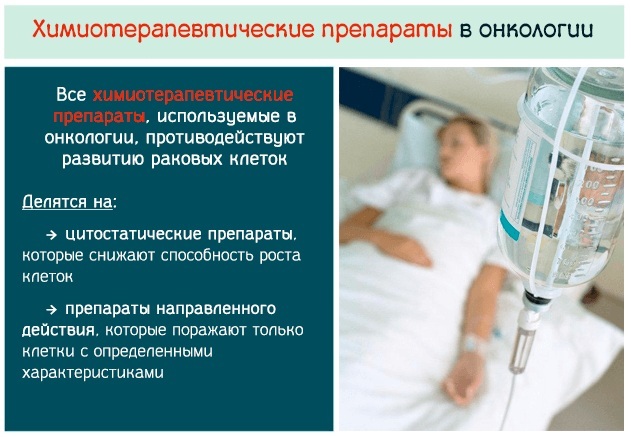Content
- History
- What are we for
- What parts does it consist of
- Views
- By appointment
- By volume
- By the number of uses
- Disposable syringes
- Simple disposable
- Insulin
- Syringe tube
- Self-locking
- Reusable syringes
- Ordinary reusable
- Syringe pen
- Syringe dart
- Syringe pistol
- Janet's syringe
- By design
- By type of attachment of needles
- Needle
- Sizing
- Length
- Varieties
- Selection recommendations
- Syringe Videos
Syringes (from the German word spritzen - to sprinkle) are widely used in cooking, manufacturing and medicine, the first attempts to inject were in ancient times. For example, the ancient Greek scientist Hippocrates, a 17th generation physician and initiator of the definition of medicine as an independent direction, administered medicinal drugs to patients with the help of venesection.
To do this, he pumped them from a pig's bladder through a wooden or reed tube. The ancient Greek word syrinx (reed) has become the basis of modern common names, which designate various types of instruments in the states of Western Europe.
History
The rudiments of the design of modern products appeared and spread in the XIV-XV centuries, but these devices were not for medical purposes. After the discovery of blood circulation and capillaries in the 17th century, thanks to the Royal Society of London that appeared at the same time, discussions began on injections with various drugs. The first injections were carried out using bird writing pens and bubbles from fish and mammals.
Despite the spread of this medical practice as early as the 17th century, syringes in the closest to the modern version began to be used for injection only 200 years later. This was preceded by discoveries made by unrelated physicians Alexander Wood and Charles-Gabriel Pravas.
In the 19th century, products consisted of a rubber vessel, an asbestos or leather piston, and metal parts. Since the container containing the potions was not transparent, the dosage marks were first applied to the iron piston grip.
Reusable glass syringes were created at the end of the 19th century by the glassblower Fournier. The base for the needle was designed by the scientist Karl Schneider, who called this end of the product a cone. Luer named after the manufacturer of medical instruments and the head of the Luer company Hermann Wulfing Luer. New glass syringes that flooded the market received patents in Europe and America, quickly spreading among Western doctors.
Despite the sterilization measures that allowed the products to be used again after cleaning, their quality declined with repeated use. Already in the middle of the 20th century, glass syringes for single use appeared in the United States; the patent for them belongs to the specialist Arthur Smith. Just a few years later, New Zealand veterinarian Colin Murdock created a plastic analogue that is still in demand today.
Formally disposable syringes can be used repeatedly, which contributes to the spread of HIV and other infections transmitted this way. To prevent this, improved tools and charities have been created, changing used products for new ones, but a reliable and equally cheap solution so far missing.
What are we for
In addition to being used in food preparation, in production and in working with equipment, the main purpose of syringes is medical. Moreover, their use is not limited to the delivery of the necessary medicinal preparations into the body.
With the help of syringes, samples are taken for analysis, and liquids and gases formed as a result of any ailments are drawn from the body cavities. This tool also has prophylactic use, and therefore it is in demand among healthy people. Vaccines are injected into the body through syringes to prevent the development of infectious diseases.
What parts does it consist of
The structure of syringes may have slight differences depending on the purpose of the products.
The main components of their design are:
- container for contents;
- a needle with a plastic tip;
- piston for supplying pressure.
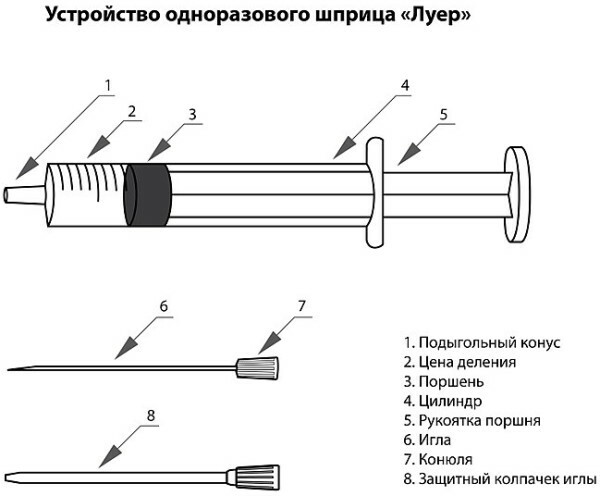
On the surface of the hollow cylindrical container for liquids, there are marks for dispensing. One end of it is the above-described Luer cone, on which a needle is put on. The second side of the syringe is open and equipped with plastic "wings" on the sides to hold the instrument in place with your fingers. A piston with a rod is installed in it, whose movement allows liquid to be injected from the container or vice versa - to create a vacuum in it for suction from the outside.
Views
Syringes for injection have structural and volume features determined by their manufacturer and specification. 30% of the types of products purchased on the Russian market are domestic products. Most of the rest of the goods come from China, Spain and Germany.
The purchases of a particular product by medical organizations are determined by the scope of the enterprise and the level of professional training of its employees, choosing products for purchase as they grow qualifications.
By appointment
The structural features of syringes for specific purposes are dictated by the convenience of their use. These products are also made in the expectation of a sufficient size for the required amount of drugs, a minimum of painful sensations during an injection, compactness and the presence of special functions. Highly specialized syringes can be made from a specific material and have special labels.
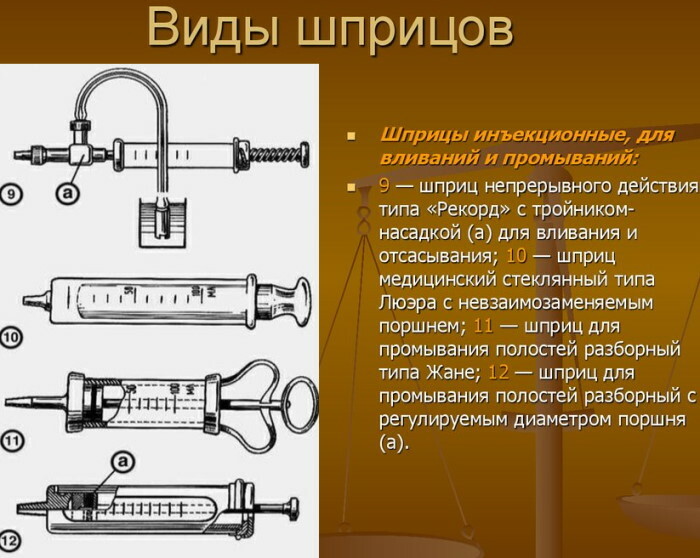
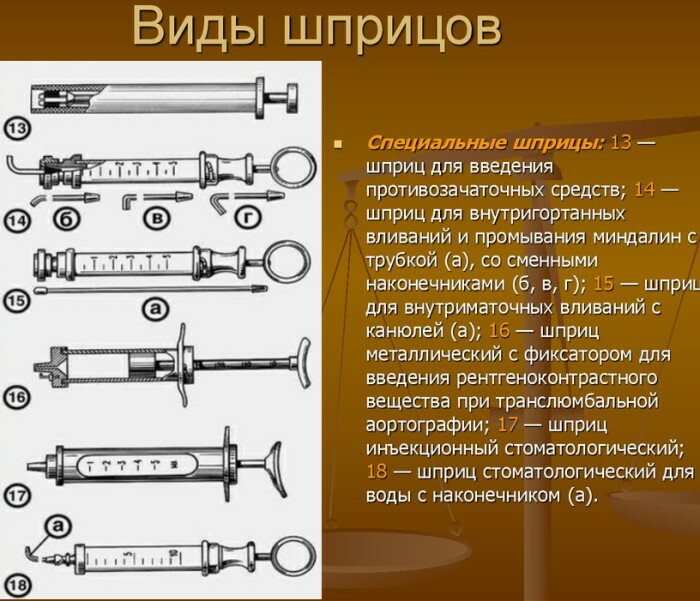
Among the most common prescription syringes are:
- common reusable and disposable syringes for injection;
- blanks for doctors on the road;
- insulin;
- for independent use;
- syringes for universal use;
- projectiles for rapid drug delivery devices;
- having a blocking function.
By volume
Syringe models have different volumes due to the dosage adopted in certain cases, as well as the specifics of the areas for injection, sampling or extractions.
Products with a capacity of 1 ml and less are classified as the smallest. They are used mainly for injecting insulin, treating tuberculosis, vaccinating and collecting the contents of allergic formations for analysis.
The volume of cylinders for medium-sized syringes is from 2 to 22 ml. Their main purpose is intravenous, subcutaneous and intramuscular injections.
Large product models hold from 30 to 100 ml. In addition to injecting and administering nutrient solutions, they are used to draw out fluids and perform rinsing.
By the number of uses
One of the main characteristics of syringes is their reusability. Products for single use are mainly in demand; they are usually made from polyethylene or polypropylene.
They are often equipped with a rubber or silicone plunger. These products are sold in a sterile and airtight wrap. Despite the possibility of re-use in many models, it is strongly discouraged to do so. In addition to the risk of infection, rust forms inside the product, and the needle becomes dull, as a result of which the injection becomes painful and damages the surface to be treated.
Reusable syringes are much less in demand.
In addition to injections, they are most often used for the following purposes:
- cleansing the inner parts of the body;
- entering food by enteral route;
- medical and cosmetic anesthesia;
- diabetes treatment;
- intravenous infusion.
Reusable injection syringes are often used with disposable needles.
Disposable syringes
Among the models intended for single use, the following types of syringes are most common.
Simple disposable
The main purpose of such products is injections; stainless steel is used as the material for the needles. Usually these are small and medium-sized syringes, although there are 50 ml specimens. They are released in sealed paper-plastic packaging, the minimum cost is a few rubles.
Insulin
Designed for the treatment of diabetes mellitus, their standard volume is 1 ml. Through these products, insulin is delivered to the body. The design of this type of syringe is designed for the most convenient and painless use at home.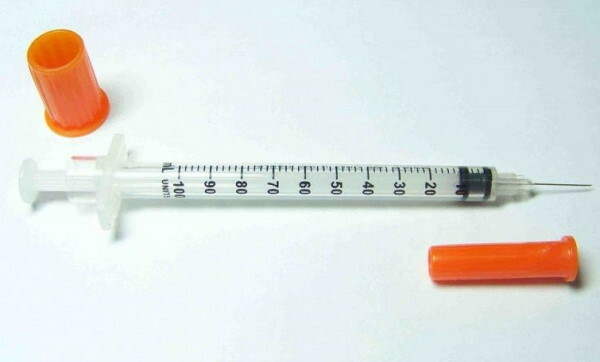
In addition to the common markings with milliliters, AU marks are applied to the surface of these products, intended for measuring insulin. These 100 units correspond to 1 milliliter.
The pistons of insulin syringes allow high precision injections, there are products for children and adults. The first ones have a marking of 0.25 or 0.5 U, the measure of the second is 1 U. Previously, syringes with a measure of 40 IU were also used, but they have already become obsolete. Syringes for the treatment of diabetes mellitus can be bought for less than 10 rubles.
A pen is also used to deliver insulin, which, although classified as disposable, can be used until the needle remains sharp. At the same time, it has a lower dosage accuracy and is not so convenient to use.
Syringe tube
It is included in the equipment of doctors on call and already has sterile medicines. They are contained in a syringe in the amount required for one unit dose. Before use, the product is stored in an airtight container; it must be ready in the medic's bag. You can buy a syringe tube for 50-60 rubles.
Self-locking
Injection syringes, types of which have the function of blocking syringes, are usually intended for mass vaccinations. They become useless after injection due to the inadequacy of the piston. This measure not only prevents the technician from reusing the product by mistake.
This way, the waste products will not cause injuries or infections as a result of unskilled use and cannot be sold in corruption schemes. Models with a lock can be purchased at a price of a few rubles.
Reusable syringes
Reusable products are predominantly made of glass. They are less in demand and among them there are more often models for alternative and specialized methods of water medicines. Among the products with the possibility of reusable models, the following types of syringes are most common.
Ordinary reusable
Fournier's glass heat-resistant products, created in the 90s of the XIX century, served as the basis for many modern models of reusable syringes. The first of these syringes were disinfected by boiling, and the metal needles blunt from the pricks were aligned with a special wire.
The current types of products for this purpose can be bought at a price of 100 rubles. They are usually equipped with replaceable needles and a number of other improvements, and much more reliable methods are used to sterilize their bodies.
Syringe pen
This model has a pen-like design and is used primarily for insulin delivery in diabetes mellitus. Just like a special insulin syringe, the pen syringe is equipped with a thin needle. Its advantage is the simplified injection process. It is carried out by pressing a button in the design of the product, after which a pre-measured dose enters through the cartridge. In this case, not all medications can be administered, leaving a supply in the syringe for the next injection.
Pen syringes are available with replaceable and non-replaceable needles. The latter need constant disinfection. If a syringe with a removable needle is used by one person, it can be changed once a week. Products are kept at temperatures from 18 ° C to 26 ° C, their average cost fluctuates around 1-2 thousand. rub.
Syringe dart
Products of this type are used as cartridges for weapons that fire sleeping pills or drugs. It is usually used by veterinarians, using it in work with both domestic and wild animals. Dart syringes are sold at a price of 40 rubles.
Syringe pistol
This tool is intended for independent use. It is loaded with syringes, the optimal volume of which is 5 ml. Such a projectile fits the dimensions of the weapon, sits firmly in the device and provides an accurate hit without damaging the skin or muscle cover.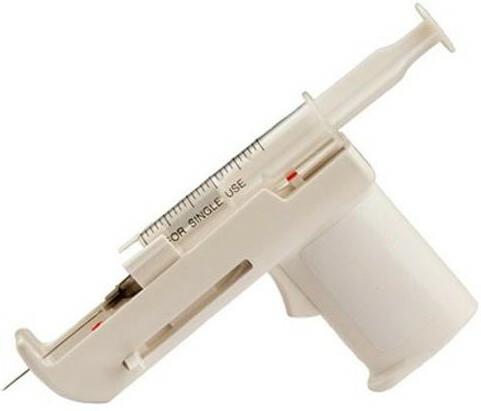
According to the description from the manufacturers, the syringe gun is characterized by high accuracy and speed of injections that do not cause painful sensations. After the shot, you must press the plunger to inject the medication. The kit for this instrument may include a permanent projectile syringe with a replaceable needle. The minimum cost of the product is about 550 rubles.
Janet's syringe
Janet's syringes have the largest volume among such devices. Typically, these products are not used for injection purposes. 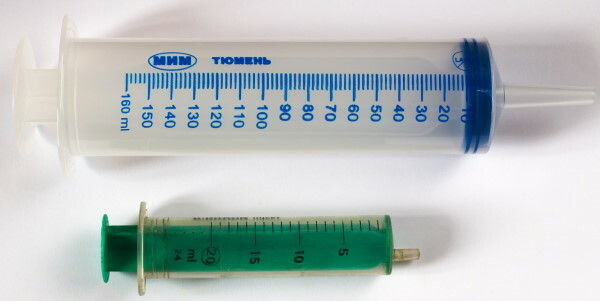 They are used for aspiration (drawing out fluids formed as a result of injuries or ailments), rinsing body cavities, introducing food or nutrients. The versatility of the Janet syringe requires its regular and thorough decontamination. It can be bought at a price of 60 rubles.
They are used for aspiration (drawing out fluids formed as a result of injuries or ailments), rinsing body cavities, introducing food or nutrients. The versatility of the Janet syringe requires its regular and thorough decontamination. It can be bought at a price of 60 rubles.
By design
Most types of syringes have 2 or 3 components. The structure of two-piece products includes a container, as well as a piston and rod. The last 2 elements are usually combined into 1 piece. In three-piece models, an additional component is a rubber or silicone seal located on the side of the piston closest to the needle.
Injection syringes (three-piece types) are more in demand. According to healthcare professionals, they are more convenient to use and have a smoother piston movement compared to two-piece models. This makes the injection process less painful. The ease of movement of this part is also found in some syringes of a two-piece design, however, they belong to expensive European products.
Another advantage of three-piece products is the position of the piston in the container. If they have it close to the walls of the container, then two-component predominantly cheap syringes are distinguished by its greater mobility. This leads to unnecessary leakage of drugs and vibrations of the needle in the treated area of the body. The rubber or silicone plunger also prevents the passage of plastic particles along with the injection compound.
Among the disadvantages of syringes with a three-piece design, the material from which the seal is made is most often called. It can cause allergic reactions in some people. For these cases, there are models with a plunger made of inert materials, which can be distinguished by the inscription "Latex free".
By type of attachment of needles
Devices for intramuscular injection differ in the way the needle is fixed to the body.
Syringes have the following types of attachment:
- Non-removable. Usually found among small disposable syringes with a volume of 0.3 to 0.5 ml.
-
Luer Lock. In this case, the needle is screwed into the fastener with the appropriate thread, which ensures maximum docking strength. Drippers and machine-driven products are equipped with this type of cones.
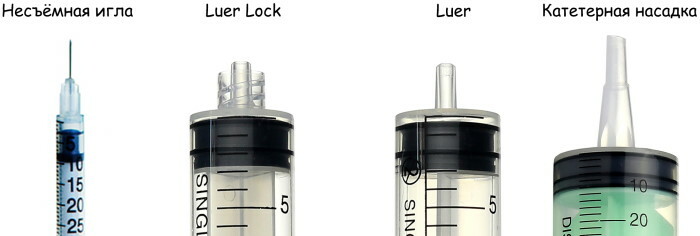
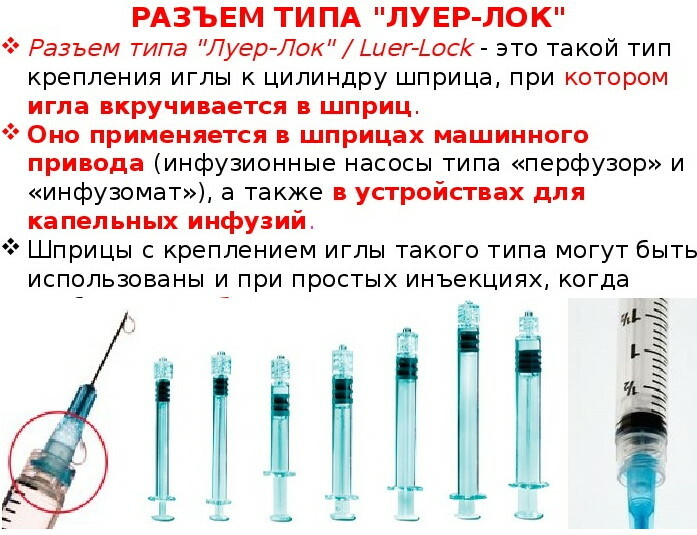
- Luer Slip. A more common mounting option in which the needle sits firmly on the taper. This allows you to perform any injections, however, if the pressure is too intense, it can simply fly off it, which is especially important when working with oily or thick compositions.
Needle
The selection of the needle depends on the purpose of the injection. Its characteristics are determined by the depth of administration of medications and directly affect the efficiency and convenience of the process.
Sizing
The specification of the needles differs from the designations used for syringes. It looks like two numbers with the letter G between them, and the needles are also distinguished by the color of the nozzle.
The following options are suitable for intramuscular injections: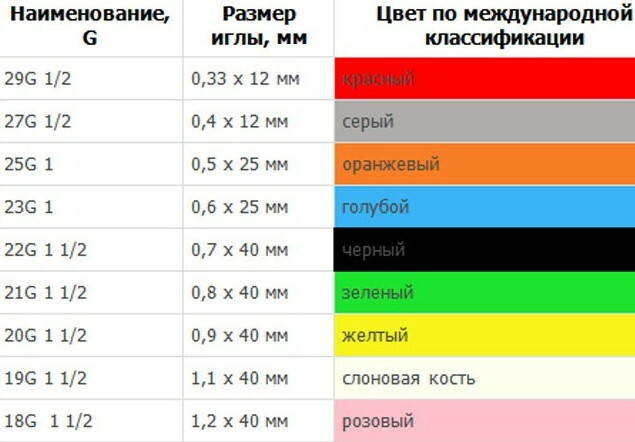
| The size | Colour | Inner diameter with needle length |
| 21Gx1 1/2 | Green | 0.8 x 40 mm |
| 22Gx1 1/2 | Black | 0.7 x 40 mm |
| 22Gx1 1/4 | Black | 0.7 x 32 mm |
| 23Gx1 1/2 | Blue | 0.6 x 32 mm |
| 23Gx1 | Blue | 0.6 x 25 mm |
Length
The permissible needle lengths for intramuscular injections are in the range from 3 to 40 mm.
Varieties
There are needles with the same thickness and decreasing towards the end. The latter have a longer period of use, while they are suitable for cases where a small diameter is required. Products with variable thickness are more often used for taking analyzes.
There are many models of syringe needles, differing in metal of manufacture, tip, gauge, wall thickness and volume. For special requests, you can order a product with the required parameters.
Selection recommendations
Syringes for injection, the types of which are designed for certain cases, have design nuances that facilitate work. Thanks to them, the injection process can be optimized in accordance with the individual characteristics of the patient.
For example, needles with a length of 4 to 6 mm are best used for adults and obese people. The lengths of 4 and 5 mm are suitable for injections for children. If you need to inject into a fold of skin or inject insulin at an angle of 45 °, a needle with a length of 8 mm should be used. Diabetic needles are also used for IVF pregnant women and newborns.
There are recommendations for the volume of syringes. For products in which it is 1 ml or less, subcutaneous injections are performed. For intramuscular use, models with a volume of 2 to 5 ml are used. These syringes usually come with suitable needles. If it is necessary to deliver medication into a vein, cylinders from 10 to 20 ml are used, also supplied with appropriate needles.
During the selection of a syringe, one should be guided by the dosage, choosing products with a small margin of volume. 0.5-1 cube will be enough.
If you need injection syringes, medical staff provide all the necessary information, but knowledge of the nuances can help you choose the tool that meets your individual requirements. It is also recommended to discuss your option with a health worker in advance. The typical period of use of syringes is 3 to 5 years and does not depend on the type of structure.
The method of disinfection and storage conditions have a greater influence. For example, these products should not be stored in direct sunlight. In syringes with a significant excess of the shelf life, the drugs are mixed with the particles of the container material. It is highly discouraged to use products from damaged packaging, without sterilization or with violations of the conditions of detention.
Author: Cash Diver
Syringe Videos
Galileo. Syringes:

